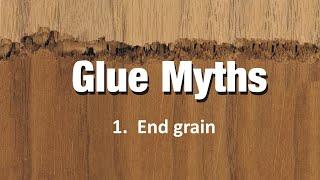Комментарии:

One factor I've often heard is that glue tends to soak into end grain, wicking into the board, which starves the joint of glue. I also imagine that, say, edge-to-edge panel glue-ups get clamped well, while end-to-whatever butt joints often don't, so anecdotal experience likely points to failed butt joints.
I still believe that "a simple butt joint is weaker than a mortise and tenon joint" which is how structural joints that matter should be constructed.

Excellent content. Not too surprising from a logical standpoint when you consider exactly what you brought up - end grain glue-ups are generally very narrow and long, making the forces acting on the glue surface area exponentially larger than the also very common long side glue jobs you see in table tops, etc.
Ответить
Guess I’ll give my splines a rest when it comes to glueing up my miters!
Edit: nm just watched his second vid lol

Very interesting.
Thank you so much for clearing this issues out.
Like your methodical approach.

omg, and i’ve avoided glueing even end-to-side and wouldn’t have considered end-to-end. thanks for this comprehensive test. brilliant.
Ответить
I can honestly say, I never bought into this myth. I "normally" think in what I call "logical mechanical thinking". The side grain of whatever wood, doesn't have any "holes" or "crevices" to sink down into. End grain has tons of little holes to go into as anchor points, almost like a bunch of small dowels. So to me, logically the end to end, would be the strongest across the board. Glad to see someone actually made a video to back up what I already believed to be true. Thanks and good job!
Ответить
'Wood Magazine ' still setting the standard in the American adult entertainment industry.❤
Ответить
as a couple have said the older style glue did not have the glue strength that modern glue does and the glue also used to break down over time.....In respect of the humidity movement question.....Wouldn't this cease to be an issue if a correct amount of glue was used as once it cures it seals the end grain and stops the movement of the moisture at the join so minimizing the expansion and contraction..
Ответить
Yea but do this same test after a few years of the wood expanding and contracting. There’s a reason commercial furniture companies dont do this.
Ответить
Hi Patrick. I thoroughly enjoyed your video. As a lifetime woodworker / retired structural and instrumentation engineer, it was a pleasure seeing someone "doing it right". Have you ever considered testing these joints in shear, rather than pure bending ? Have you published your actual numerical results somewhere? I'd love to see them. Thank you for all the work that you put into producing this video.
Ответить
Excellent series on glue ups. How about stain, then glue? I know stain pigment fills the pores, but how much does it affect the glue? Water based vs oil, fine grain vs open grain would be interesting.
Ответить
The conclusions are based on a false premise, the real reason we don't glue end grain is an end-end glue joint experiences the most seasonal movement. Large amounts of seasonal movement on even a lightly stressed joint causes a glue line failure. Gluing end grain can work on something with essentially zero stress like a miter but that's about it.
Ответить
Now we need to test scarf joints. ;-)
Ответить
Hmmm... A better summary statement might be "Glue is stronger than lignin; therefore, a properly prepared end-grain to end-grain joint is stronger than a joint with one or both surfaces composed of long-grain assuming that the compared joint surfaces are of equal size and geometry, and equal bearing distances from the loaded glue joint for deflection loading." Not as snappy, but it has much less wiggle room to go astray in.
Ответить
I learned something here. Thanks.
Ответить
Excellent presentation!
Ответить
Wood moves over time and that's why end grain joints don't last. They weaken as the weird moves until they eventually fail.
Ответить
Wonderful explanation and experiment. You've converted me from a fallacy.
Ответить
Two thumbs up. You are a wood workers mentor and hero. thanks much!
Ответить
Ya done good, real good!
Ответить
Finally, someone with actual engineering knowledge 👏👏
Ответить
Nice. Thanks for the research.
Ответить
It would be interesting to perforate the end grain with different sized holes/patterns to see how it affects the strength of the bond, especially if you used epoxy as the glue
Ответить
This felt blasphemous to watch as a young woodworker. I'm in college for furniture design, and this feels contrary to everything I've learned from my professors and such, but it makes perfect sense.
I mean, every part on it's own felt obvious. Of course the glue is stronger than lignin, that's one of the first things I learned. Of course wood's strength is in the direction of its grain, that's obvious. Naturally then, a joint between two pieces of wood in the orientation where they're strongest is going to be stronger than a joint in an orientation in which they're weakest...
Connecting these ideas feels weird and wrong somehow though... But yeah, adopting this into my worldview now... thanks, Pat

I've been saying it for years
Ответить
This was very educational, thank you for going to all the trouble of making it.
Ответить
Great work : this is very important information. Thank you for doing this.
Ответить
Do we abandon scarf joints?
Ответить
I watched this brilliant video after watching a steve ramsay video, and he reminded me of your research video. I will certainly watch and learn more
Ответить
Id really love to see this test on the popular dowel joint on end to end, side to end, side to side format
Ответить
I never believed the myth
Ответить
It is going to depend a lot on the tightness of the grain. Glue can wick into the grain and leave none on the surface. You get a similar effect with paint. I would expect loose grain end joints could be made stronger by initially priming the surfaces until the grain is filled.
Ответить
Thank you for going metric, rest of the world thanks you.
Ответить
I spent my career in electro-mechanical engineering, then retired and been involved with woodworking. I've been amazed at the amount of "anecdotal" wisdom that is taken as fact in woodworking. One other example is the wisdom that veneer cannot be formed over an organic surface, with high end (Bentley/Rolls) having been doing it for dash panels with burl veneer for decades.
Ответить
What about what happens to pva glue over decades? Does it remain strong or start to crack and separate from wood? If so then it would be weaker than a joint that has wood reinforcement like a tenon, spline or dowel etc, no?
Ответить
Eye-opening! Thanks for carrying out such a carefully designed, well controlled experiment. A truly hyphothesis-based experiment, aimed at establishing whether "wisdom" agrees with reality. I guess testing mitre joints (or scarf - since they involve similar wood-to-wood contacts) would be a useful addition, then add results as a fourth colour to your excellent graphical summary. And now I've just seen this was already done in your next video. So - I'll now watch all your fascinating tests and exploration of myths. Last question - have you search for engineering literature on these matters? There must be some research from mechanical engineers & their students, but probably needs exploring scholarly literature. Thanks again!
Ответить
Patric, fantastic video! I too have held this false belief for over 70 years. Now please excuse me, I need to put on my N95 mask and drive alone in my pickup truck to the hardware store to buy more wood screws. 😁
Ответить
This whole comparison is a bit silly. An end grain butt joint makes wood LONGER. A long grain joint makes wood WIDER. If you're actually trying to show something useful, compare a scarf joint or a finger joint to a butt joint. If you're loading a piece of wood across the grain, you don't know much about wood.
Ответить
excellent work!
Ответить
All wood workers should watch this scientific test!
Ответить
After this video I'd be curious to see how finger joints compare to mid section wood breaks. If the fibers cross the joint plane due to rhe joint geometry, I wouldn't be totally shocked to see it approaches no joint strength.
Ответить
This is such a well-made and helpful video, glad I found your channel
Ответить
I know nothing about woodworking, I'm just here to roleplay as Ron Swanson
Ответить
Awesome video
Ответить
Thank you sir...well done
Ответить
Wow what an amazing video I’m so glad I found it! Would finger jointing the ends before you glue them together help to make it stronger?
Ответить
When I first saw this video last year a was making a project (a long over the bed light), and wasn't sure how to design the back piece. It had to be two pieces and I wasn't sure how to join them. This video assured me end grain to end grain was strong so I figured why not try it. The joint didn't have much stress on it anyway I thought.
Well this morning I needed to make some alterations to this project and while doing so I noticed that joint failed. The piece is such that I couldn't open the gap enough to get more glue in, but it was completely broken at the seam. So I had to route out a section quarter inch deep and put a piece of quarter inch oak spanning the now broken joint. Basically created big rabbits and then glued the oak long grain spanning the seam. That's probably how I should have done it to begin with, but again this video made me confident I didn't have to mess around and could just glue the boards together.
This was super annoying as it basically wasted half my day that I was planning on doing another project. And now I can't even install the light again for another few days since it has to dry, then sand, then finish, then dry.
Lesson learned. Screw end grain joints. Just do things properly the way actually good woodworkers have been doing for decades. Always get long grain crossing your joints. Just because something tests strongly two days after having been made doesn't mean it will hold up over the course of a decade. Mine didn't even last a year.

I am shocked
Ответить
I think this all makes perfect sense. The end grain allows the glue to sink in deeper thus making a stronger joint
Ответить
The sad thing is people are not hearing what you are saying but what they think you are saying. Do you think natural oil content would affect these values?
Ответить



















